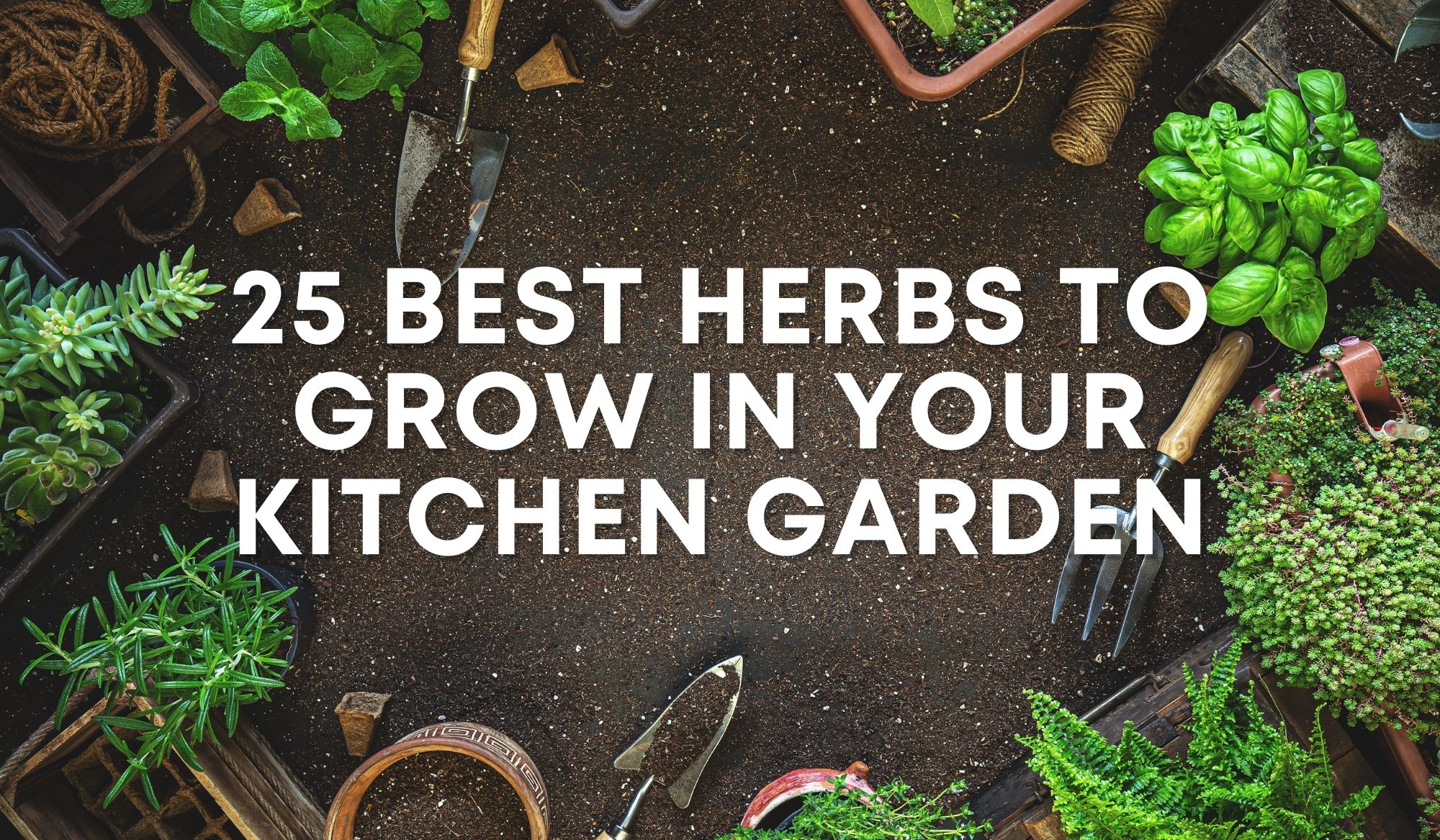by Kenan White | Jan 13, 2022 | Basics, Books & Design, Flowers, Gardening, Herbs, Inspiration, Miscellaneous, Wildlife |
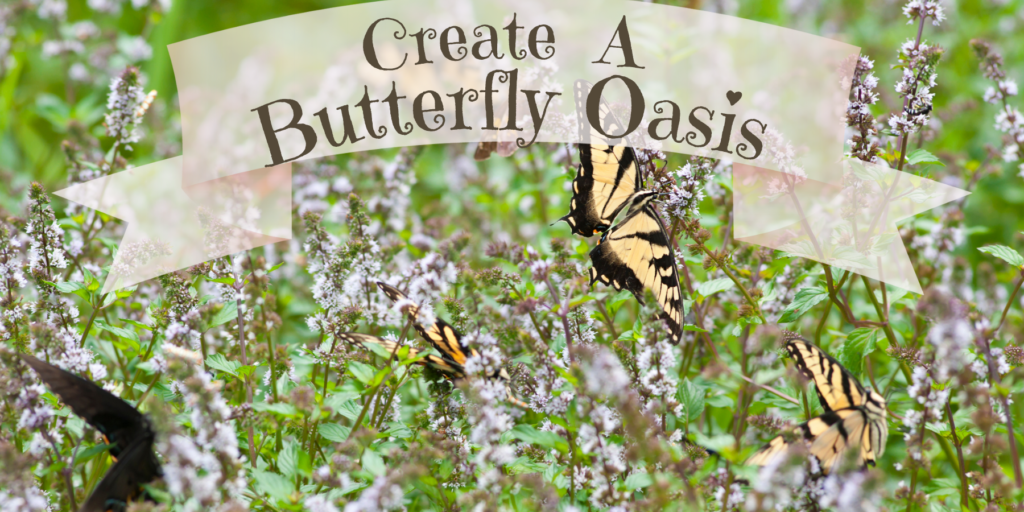
Butterfly gardening can be a wonderful way to experience wildlife in your garden, encourage pollination, and it takes very little maintenance, giving you more time to enjoy the beauty of watching butterflies flock to your plants. Many people who have maintained a butterfly garden for such a long time actually enjoy having visitors to come and look at their creation. This is also a great way to give back to your local ecosystem, as many natural habitats for butterflies and other pollinators have been destroyed by urban development and human interference. We always let about half of our test garden go wild in the summer, in addition to the many flowering shrubs and trees throughout the yard, to give butterflies a safe place to feed and lay their eggs. This is common practice, and we let this happen until the flowering shrubs and trees start to become an issue.
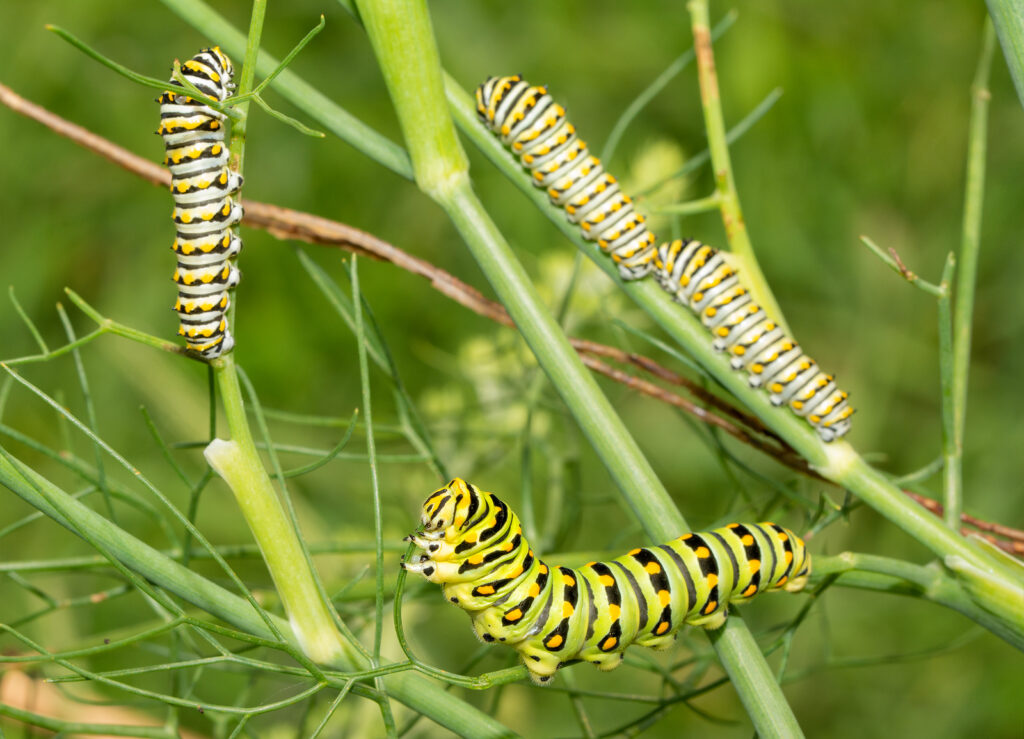
Here’s a wonderful photo showing a Fennel plant hosting Eastern Black Swallowtail butterfly caterpillars
In planning your butterfly garden, make sure to plant plenty of host plants and feeder plants. Host plants are specific herbs, flowers and other plants, that mature butterflies lay their eggs on because they create a safe haven for their young who will also feed on these plants once they become caterpillars. Be aware that these plants will be the sole food source for caterpillars, so it will be pretty heavily snacked upon. Because these may look rather ragged by the time the caterpillars are done munching on them, you may want to add these to the back of your garden, but still close to feeder plants so that the caterpillars are able to find them easily in their next stage of life. Some common host plants include Fennel, Italian Flat Leaf Parsley, Dill, Broccoli, Sunflowers, and Butterfly Flowers (also known as Milkweed).
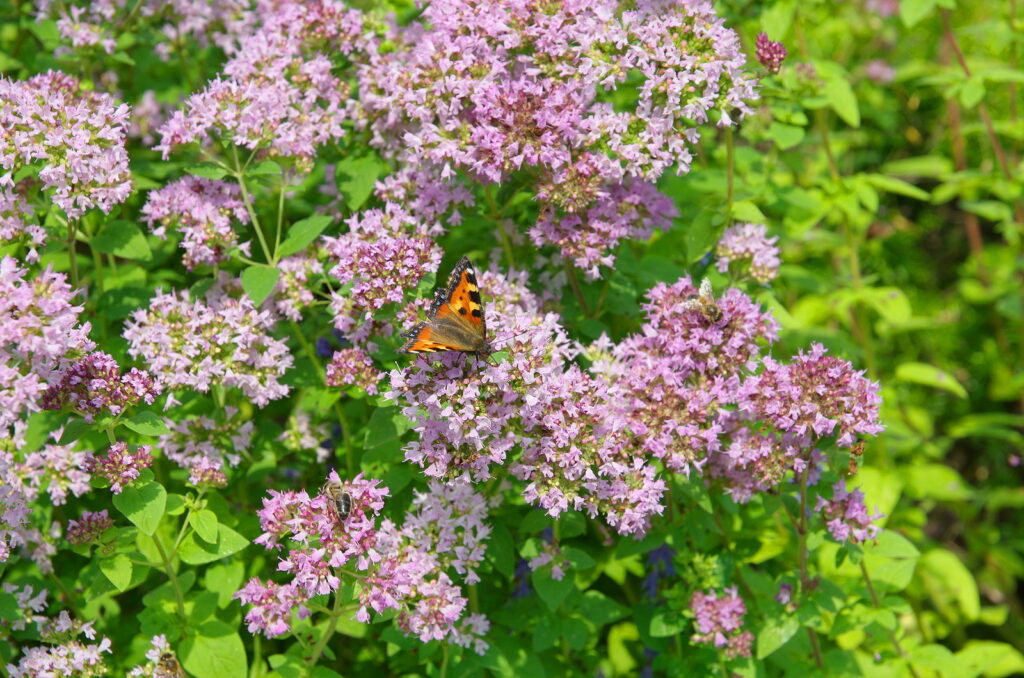
Butterfly on the flowers of oregano (lat. Origanum vulgar)
Feeder plants are nectar rich plants that adult butterflies will feed on throughout the season. These will also attract other helpful pollinators to your garden like honeybees and hummingbirds! Feeder plants tend to be fragrant and brightly colored, and you may be surprised to find that you already have many in your garden already. Some common varieties from our garden include Lantanas, Buddleias (also known as “Butterfly Bushes”), Joe Pye Weed, Bee Balm (Bergamot), Garlic Chives, and Oregano.
- Remember to plant your perennial butterfly plants toward the back of your garden and your annuals toward the front, for easy seasonal replacing.
- Don’t forget to incorporate herbs into your butterfly garden! Many herbs are perennial and will provide you with a safe haven for caterpillars and beautiful blooms when they flower. You can also use them in many other ways!
- Choose an area that is protected by the wind, as butterflies are delicate and don’t want to fight strong breezes to feed.
- Provide a water source, such as a birdbath or a shallow bucket filled with water with sand in the bottom.
- Avoid using pesticides on your plants as these will harm the butterflies and their young.
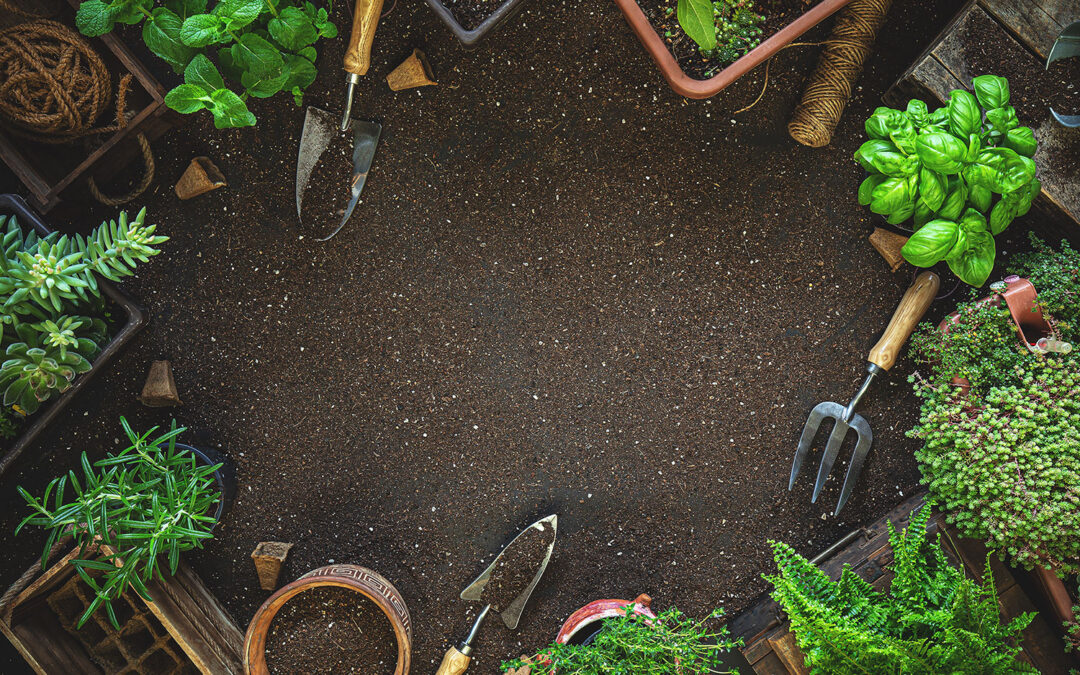
by Kenan White | Feb 12, 2021 | DIY Gardening, Gardening, Herbs, Indoor Gardening |
Whether you want to grow a kitchen herb garden as a hobby or to save money or just for healthier eating, there are plenty of herbs you can grow in your backyard, on your patio, or even on your windowsill. Fresh herbs make recipes taste even better and are great to have around for soups, stews, and salads.
In picking a place to grow your herbs, keep in mind that they need a good four to six hours of sun daily. There are many herbs that you can grow to enhance your cooking. When you plant a kitchen garden, don’t only plant the herbs you know, take a chance on something else. You might just be surprised.
Here are fresh herbs and plants you can grow that are great to have handy in the kitchen.
[wps_products product_id="4317114826833" excludes="title, pricing, description" show_featured_only="true"]
PARSLEY
Parsley is a mild bitter herb that can enhance the flavor of your foods. Many consider parsley just to be a curly green garnish for food, but it actually helps things like stews achieve a more balanced flavor. As an added benefit, parsley can aid in digestion. By reading articles such as unify health labs reviews and other digestion related discussions, many supplements and herbs are uncovered as great helpers for the digestive system. Parsley is often grown as an annual, but in milder climates, it will stay evergreen all winter long. Parsley plants will grow to be large and bushy. Parsley is a good source of Vitamins A and C.
[wps_products product_id="4317114073169" excludes="title, pricing, description" show_featured_only="true"]
MINT
There are several varieties of mint. You can use it in drinks like mojitos or mint juleps. Or add some mint to your summer iced tea. Mint freshens the breath and will help to calm your stomach. But if you grow mint, remember that it’s considered an invasive plant. Mint will spread and take over your garden. It’s best grown in containers.
[wps_products product_id="4317111582801" excludes="title, pricing, description" show_featured_only="true"]
DILL
Dill is a great flavoring for fish, lamb, potatoes, and peas. It also aids in digestion, helps to fight bad breath and has the added benefits of reducing swelling and cramps. Dill is easy to grow. It will also attract helpful insects to your garden such as wasps and other predatory insects.
[wps_products product_id="4317110206545" excludes="title, pricing, description" show_featured_only="true"]
BASIL
Whether you choose large leaf Italian basil or large purple sweet basil, this plant is popular in many cuisines but is a feature in Italian cooking like pizzas, salads, sauces, and pesto. Some people think basil is great for planting alongside your tomatoes but there’s no real evidence that it makes your tomatoes taste sweeter. Basil has health benefits of antioxidants and is a defense against low blood sugar.
[wps_products product_id="4317115416657" excludes="title, pricing, description" show_featured_only="true"]
SAGE
Sage is an aromatic herb that is great for seasoning meats, sauces, and vegetables. But be careful because sage will have a tendency to overpower other flavors. Sage also helps to relieve cuts, inflammation and helps with memory issues. It was once thought to be a medicinal cure-all. Sage is an easy herb to grow and is relatively easy to care for. It’s great in your garden for attracting bees.
[wps_products product_id="4317115154513" excludes="title, pricing, description" show_featured_only="true"]
ROSEMARY
Rosemary is one of the most flavorful herbs and is great for adding to things like poultry, meats, and vegetables. Around Christmastime, you’ll see tree-shaped rosemary bushes for sale. You can bring them home and keep them for planting in the spring. The fragrant plant is a delightful scent and is sometimes used in floral arrangements. Rosemary likes its soil a bit on the dry side, so be careful not to overwater. Allowed to flourish, a rosemary plant will grow into a full-sized bush.
[wps_products product_id="4317116203089" excludes="title, pricing, description" show_featured_only="true"]
THYME
Thyme is a delicate looking plant. It is often used for flavoring egg, bean and vegetable dishes. Thyme is frequently used in the Mediterranean, Italian and Provençal French cuisines. Pair it with lamb, poultry, and tomatoes. Thyme is often added to soups and stews. Thyme is part of the mint family. The most common variety is garden thyme which has gray-green leaves and a minty, somewhat lemony smell.
[wps_products product_id="4317111156817" excludes="title, pricing, description" show_featured_only="true"]
CILANTRO / CORIANDER
Cilantro is also known as coriander leaf or Chinese parsley. Cilantro is perfect for adding into spicy foods like chills, and Mexican, Chinese, Southeast Asian and Indian cuisines. The seeds of cilantro are known as coriander. The plant grows early in the season and doesn’t like it when the ground becomes too warm.
[wps_products product_id="4317111484497" excludes="title, pricing, description" show_featured_only="true"]
FENNEL
Fennel is very flavorful and aromatic, and along with anise is a primary ingredient in absinthe. Fennel is native to the Mediterranean region and does best in dry soils near the ocean or on river banks. The strongly flavored leaves of fennel are similar in shape to dill. The bulb can be sautéed or grilled, or eaten raw. Fennel bulbs are used for garnishes or sometimes added to salads.
[wps_products product_id="4317111418961" excludes="title, pricing, description" show_featured_only="true"]
CHAMOMILE
In the United States and Europe, chamomile is most often used as an ingredient in herbal tea. It is one of the world’s most widely consumed herbal teas. But it has also been used for thousands of years as a traditional medicine for settling stomachs and calming the nerves. Chamomile also helps reduce inflammation and treat fevers. You can grow either German chamomile or Roman chamomile. The two are interchangeable when it comes to making tea, but they are grown very differently. German chamomile is an annual plant that grows up to three feet tall. Roman chamomile is a perennial but only grows to about a foot high. German chamomile is more commonly known for its blossoms.
[wps_products product_id="4317115842641" excludes="title, pricing, description" show_featured_only="true"]
FRESH TARRAGON
French tarragon is the traditional ingredient of ‘Fines Herbes’ and is the aristocrat of fresh herbs. A must-have for any Culinary Herb Garden! It will transform an ordinary dish into a work of art with it’s spicy anise flavor. A little tarragon in a chicken salad makes a profound difference. It is wonderful in sauces, soups and meat dishes. Try it with vegetables. It is the choice for any hearty dish.
[wps_products product_id="4317112991825" excludes="title, pricing, description" show_featured_only="true"]
LAVENDER
Grown as a condiment and for use in salads and dressings, lavender will give most dishes a slightly sweet flavor. Lavender syrup and dried lavender buds are used in the United States for making lavender scones and marshmallows. Health benefits include the soothing of insect bites and headaches when used with herbs and aromatherapy. Lavender plants will survive in many growing conditions but do best in full sun in warm, well-drained soil.
[wps_products product_id="4317111779409" excludes="title, pricing, description" show_featured_only="true"]
CHIVES
Chives are a member of the garlic family and can be the perfect complement to sour cream. Chives are mostly used for flavoring and are considered one of the “fine herbs” of French cuisine. Chives are native to Asia but have been used as an additive to food for almost 5,000 years. Chives work well with eggs, fish, potatoes, salads, shellfish, and soups. Chives are an excellent source of beta carotene and Vitamin C.
[wps_products product_id="4317109944401" excludes="title, pricing, description" show_featured_only="true"]
ARUGULA
A member of the Mustard family, Arugula is a leafy green that packs a peppery punch! Similar to Watercress in flavor, Arugula has edible, aromatic leaves and a spicier flavor than most greens. Often eaten raw in salads, Arugula also tastes great when cooked. If you’re adding it to a pizza, pasta, or pesto, make sure to add it last or just after the meal is done cooking to prevent the leaves from withering.
[wps_products product_id="4317110992977" excludes="title, pricing, description" show_featured_only="true"]
BAY LEAVES
The smell of bay’s noble leaves reminds you of balsam, clove, mint, and some say even honey! Well known for its use in hearty stews and other long-simmering dishes with a slightly sharp, peppery, almost bitter taste. Add the whole leaves at the beginning of the cooking process and remember to remove them before serving. Sweet bay is native to the Mediterranean.
[wps_products product_id="4317113712721" excludes="title, pricing, description" show_featured_only="true"]
LEMON VERBENA
Lemon Verbena is a useful culinary herb, used in teas, salads, dressings, and desserts. A wonderful herb plant that will do very well when potted for container gardening or in an indoor herb garden. Made popular as a perfume centuries ago when introduced by Spanish conquistadors who had found the aromatic herb in South America. Since that time Lemon Verbena has been used in everything from recipes to soaps. Because Lemon Verbena holds its citric fragrance long after being dried, it makes a great addition to potpourris and herb pillows and can be used in closets and drawers to freshen laundry.
[wps_products product_id="4317111681105" excludes="title, pricing, description" show_featured_only="true"]
CHERVIL
Chervil produces flat, light-green, lacy leaves with a hint of anise, and enhances the flavor of chicken, fish, vegetables, eggs, and salads. It is an heirloom herb that was most likely introduced to European herb gardening by the Romans. Closely related to Parsley, chervil has become an indispensable herb plant in the kitchen, and a classic among herb plants in French cuisine.
[wps_products product_id="4317115580497" excludes="title, pricing, description" show_featured_only="true"]
WINTER SAVORY
A deliciously spicy culinary herb, Winter Savory adds an aromatic flavor to many dishes. Also used medicinally for its antibacterial and anti-fungal properties. Winter Savory, like its Summer counterpart, is a spicy culinary herb from the Mint family that compliments fish, beans, and poultry with its intense flavor. Though it loses some of this intensity during the cooking process, Winter Savory remains aromatic and is often used to flavor liqueurs and makes a beautiful garnish to any salad.
[wps_products product_id="4317113909329" excludes="title, pricing, description" show_featured_only="true"]
PEPPERMINT
Like other mints, peppermint is known for aiding digestion and freshening the breath. But peppermint is also a good source of calcium, potassium and Vitamin B. Peppermint is a hybrid mint, being a cross between water mint and spearmint. Peppermint oil can be used for flavoring but is also useful as a natural pesticide. It has been shown to reduce the effects of irritable bowel syndrome. Peppermint prefers rich soil and partial shade. Like other mints, it spreads quickly, so consider planting it in containers.
[wps_products product_id="4317115711569" excludes="title, pricing, description" show_featured_only="true"]
STEVIA
Stevia is an attractive looking plant and a natural sweetener. The added benefit is that there are no calories. Stevia is part of the sunflower family and is native to subtropical and tropical regions in the Western hemisphere. While it’s a perennial plant it will only survive in the milder climates in North America. Still, you can add stevia to your garden for the summer. It is also known as sweetleaf or sugarleaf and is grown for its sweet leaves. Stevia can be used as a natural sweetener and as a sugar substitute.
[wps_products product_id="4317113745489" excludes="title, pricing, description" show_featured_only="true"]
LEMONGRASS
Lemongrass stalks can provide antioxidants such as beta-carotene and a defense against cancer and eye inflammation. Lemongrass has a strong lemon flavor. You can brew it in tea as well as use it as an herb seasoning. To grow this outdoors, you need to live in at least Zone 9. Outside it can grow up to six feet high but will be notably smaller if you grow it indoors.
[wps_products product_id="4317110403153" excludes="title, pricing, description" show_featured_only="true"]
BERGAMOT (BEE BALM)
Gaining renewed popularity as a culinary herb, Bee Balm makes a wonderful addition to pizzas, salads, breads and any dishes that are complemented by the herb’s unique flavor. Minty and slightly spicy, Bergamot makes a great substitute for Oregano. Bergamot has a long history of use as a medicinal plant by many Native Americans, including the Blackfeet. The Blackfeet Indians used this hardy perennial in poultices to treat minor cuts and wounds. A tea made from the plant was also used to treat mouth and throat infections caused by gingivitis, as the plant contains high levels of a naturally occurring antiseptic, Thymol, which is found in many brand name mouthwashes.
[wps_products product_id="4317114269777" excludes="title, pricing, description" show_featured_only="true"]
OREGANO
Oregano is also part of the mint family and is native to the warm climates of Eurasia and the Mediterranean. Oregano is a perennial plant but in colder climates can be grown as an annual. It is sometimes called wild marjoram and is closely related to sweet marjoram. Oregano is used for flavoring and is a staple herb of Italian American cuisine. In the United States, it gained popularity following World War II as soldiers returned home with a desire for the “pizza herb.”
[wps_products product_id="4317112238161" excludes="title, pricing, description" show_featured_only="true"]
CUTTING CELERY
A more flavorful choice than its crunchier cousin, Cutting Celery is a leafy, aromatic herb that can be substituted for celery in dishes if you want to add flavor without the stringy fibers. Often mistaken for flat-leafed Parsley, Cutting Celery has a dark, glossy leaf with a serrated edge and small sprig-like stalks. The leaves and stems can be used to add flavor to salads, vegetables, stews, and soups.
If you grow your herbs indoors you can enjoy them fresh year-round. But if that’s not an option, consider freezing or drying some of your own herbs to have available for cooking year-round. When you’re ready to buy herb plants, please check out our online store.
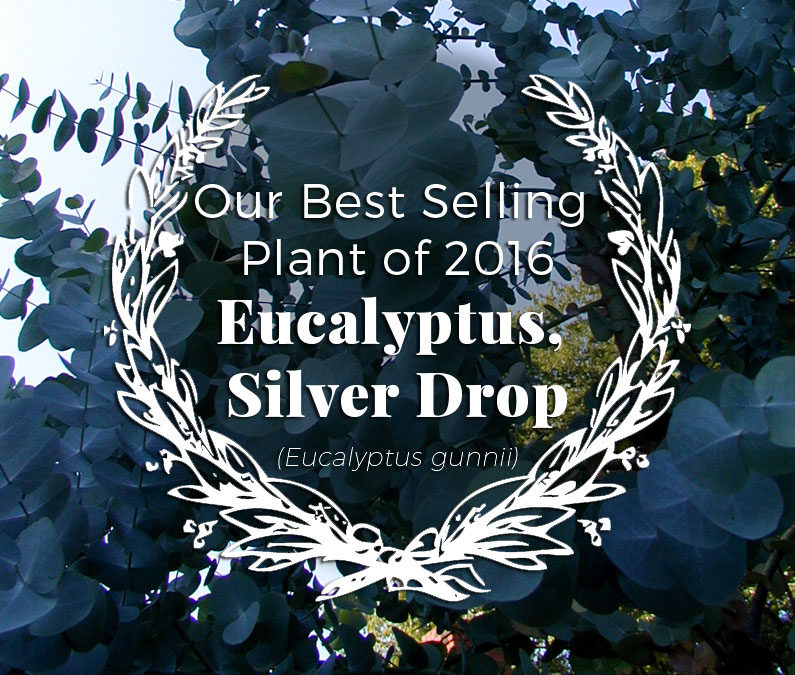
by Kenan White | Dec 28, 2016 | A Year in the Life.., Inspiration, Miscellaneous |
It’s nearly the end of 2016, and time for us to recount the highs and lows of this past growing season. We all have our areas of interest, but for me, it’s all about you …. Trends in what gardeners wanted this past growing year. Basically, what plant sold THE BEST in 2016.
And, the winner is: Eucalyptus, Silver Drop. Always in the top 5, but never a winner. This year, Eucalyptus pushed out Lemongrass and would have done even better had we not run out near the end of the spring.
(more…)
by Kenan White | Feb 17, 2016 | Exploring, Recipes |
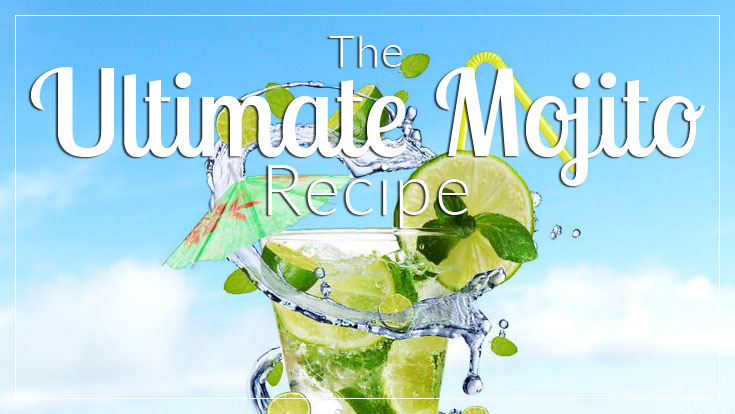
A perfect drink for a warm sunny day, or even a cold wintry day when you want to feel like you’re at the beach. A few years ago, we began growing Mojito mint – what a plant! Like all mints, it is easy to grow and provides plenty to cut. But, the added attraction is that this is the real deal and an essential ingredient in a mint mojito, a cool summer drink that has been popular in Cuba since the 1920’s.
Remember the secret: fresh mint that is crushed with sugar to release the mint’s essential oil.
Bonus tip: if you grow this indoors, you can enjoy fresh mojitos all year long. (more…)
by Kenan White | Nov 16, 2015 | Herbs, Miscellaneous |
When many people think of herbs, they think of cooking. There are so many other uses for them! For example, herbal extracts like CBD oil from companies like GoldBee.com are useful in treating mental health issues, skin care problems and even reduce chronic pain symptoms. Take the list of herbs below and you have several natural ways to solve your everyday ailments. Go ahead and treat your acne with basil, clean your toilets with thyme, and build your bones with marjoram. Have fun exploring new ways to use herbs!

Rosemary: Mosquito Deterrent and Hair Rinse
To keep mosquitos away from your porch or other areas where you like to entertain guests, try growing rosemary in close proximity. Mosquitos do not like rosemary and so they will stay clear of that area. Another great use for rosemary is as a hair rinse. To strengthen your hair and eliminate pesky dandruff, rinse your hair in a cooled solution of boiled rosemary leaves and water.
Buy the plants online
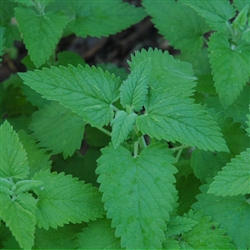
Lemon Balm: Fatigue Treatment
To reduce your fatigue, make a tea out of equal parts lemon balm, raspberry leaf, mettle, and oat tops. Add ¼ part each of sliced and sifted ginger and licorice. Re-boost your energy by drinking 3 cups every day.
Buy the plants online (more…)





